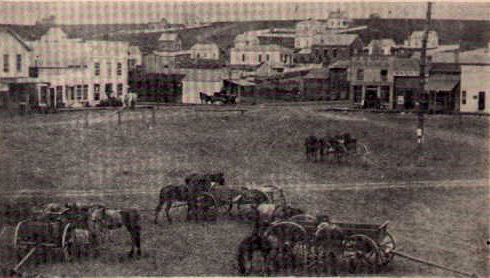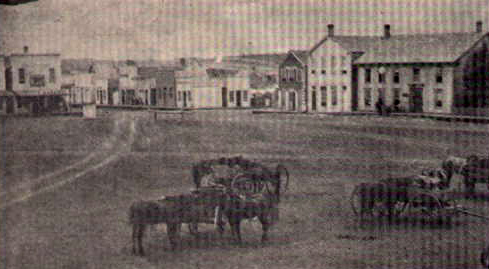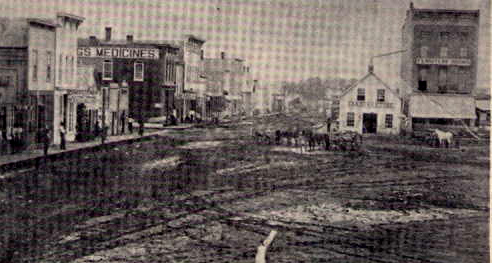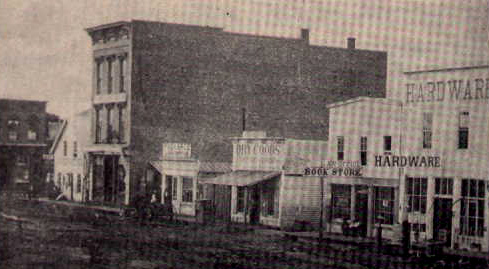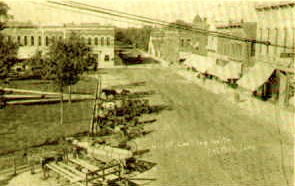Pioneer
O. P. Worsley
THE SUN, Red Oak, Iowa, Friday, April 4, 1919
|
Red Oak, Iowa, 1870 |
|
Photos from Cavalcade of a Century |
|
Northeast Corner of Red Oak Square |
|
|
|
|
Southeast Corner of Red Oak Square |
|
|
|
|
Southwest Corner of Red Oak Square |
|
|
|
|
West Side of Red Oak Square |
|
|
|
|
East side of Red Oak Square |
|
|
|
CAME HERE AS A PIONEER O. P. Worsley Came Here 50 Years Ago Wednesday---Tells Many Interesting Facts. O. P. Worsley, secretary of the Mutual Life Association of Iowa, has lived in Red Oak for 50 years. He came here as a young man, took an interest in the welfare of the community from the start and has done much towards building up Red Oak.
When interviewed Wednesday by a SUN man, Mr. Worsley was in a reminiscent mood and the following interesting facts about Red Oak in an early day were brought out in the chat: “Fifty years ago today I crawled out of a stage coach in front of the station on the south side of the square and found myself in Red Oak and Red Oak has been my home ever since. The trip from Pacific Junction had been a long one. The stage left that place in the morning and it was nearing midnight when a tired young fellow, who had made most of the trip alone, gathered himself together at his destination. I went to the old Red Oak House, which was the next-door to the station and applied for a room. Having been shown to a large garret, which contained about 20 beds. I went to sleep in the one assigned to me and left no call for the morning. When I awoke next morning late, I was the only occupant of the room. I dressed, went down stairs, found that breakfast was over and the landlady was doing a washing in the dining room. She was a kindly lady, however, and stopped her washing to prepare me something to eat. While I was eating my first meal in Red Oak, I learned from my landlady who had resumed her task over the tub, that J. W. Small, the party whom I wished to see, was some 12 miles in the country. Mr. Small was the first city clerk of Red Oak and we later became brothers-in-law when he was married to my sister. I was tired, having left my home at Geneva, Ill., and gone to Pacific Junction by rail and from there to Red Oak by stage, but as Mr. Small was the only person in the new country that I knew I was anxious to see him, so I walked out to the Andrew Powell place, north of town, where he was. It was on a Friday that I arrived in Red Oak and I spent Saturday and Sunday with Mr. Small, returning on Monday to look for work. When I came to Red Oak I had my mind made up to “stick”. During the Civil War I had been managing our farm near Geneva, but I had found time to do several jobs of house painting. Very few of the houses in Red Oak were painted so I decided to seek work in that line. But I found that in most cases after the houses were built there was little money left for painting and work did not come very rapidly at first. However, I found work enough so that I was not forced to join one of the construction gangs which were building the railroad through Red Oak at that time. Red Oak didn’t amount to very much half a century ago. On the south side of the square, where the Reifel building now stands, was a brick building where D. W. Montgomery conducted a general store. Then west of that was the Red Oak house, with the big garret room and the 20 beds, with the stage station and office, which stood where the Otis building now stands. Where the Red Cross drug store is now located was Henry Shank’s drug store and that was all there was on the south side. On the west side of the square, where Robinson’s store is, was where C. H. Lane had his general store and the post office was also located there. Then it was vacant until you come to the Rogers building next to the alley, where H. Roberts & Son had a general store. Then, where the Farmer’s Mercantile Co. store is, Web Eaton was putting up a building to house his newspaper office. No other buildings stood on the west side, but across the street, where the Farmers National bank stands, was a frame building which was later moved to the opposite corner of the block and remodeled into the L. M. Doctor residence. The north side of the square was vacant until you come to where Sanford’s store is located and there Good & Richards had their law office in a frame building. The old court house that was brought down from Frankfort the winter before on skids, stood next. It was set back some 20 or 25 feet from the lot lane and in the corner of the lot was a farm bell hung from a post with which court was called. Then it was vacant up to the Red Oak National Bank corner, where W. H. Kerrihard, who had a sawmill down on the river bank, conducted a general store. Then going east on Reed-st., there were no buildings until just opposite the Sun office, stood a blacksmith shop. The east side of the square boasted the best buildings in town. It was all vacant north of the alley, but about where Myer’s furniture store is located was a two-story building, the first floor being occupied by an Ottumwa store company, while the Masonic lodge used the second floor. This was the best building in the town. On the corner where the grocery store is now, Cooley & Wiley had a store and east from there, about where the tailor shop is located, was a drug store owned by Geo. Holmes. Where the Griffith Inn now stands was a hotel, conducted by L. N. Harding. Then across the street on the old post office site, was Clark’s drug store, and next door was a saloon. Back of the Reifel building was a livery stable and where the Red Oak hospital now stands were the stage company’s barns. That, I believe takes in all the business section of Red Oak in 1869. There was just one school building in Red Oak, a one-story brick, which stood on Corning-st., between Fourth and Fifth-sts. The Methodist church was the only one in the town and stood across the street north from the present site. The building was a brick and is still standing. It is owned by Will Irwin and is used as a modern apartment house. The parsonage occupied the Paul Clark lot. The only building in the Congregational church block was owned by Joseph Barker; E. L. Sickmon had a house where the Dan Reifel house now stands and J. B. Packard’s home was on the H. C. Houghton, Sr., lot. That same spring I formed a partnership with J. N. Small under the firm of Small & Worsley and bought the lot where the Red Oak Trust & Savings Bank is located. A two-story frame building was erected, where we engaged in the mercantile business handling books, stationery, soft drinks and other things. That was my first business venture. One year later I sold my interest to F. M. Byrkit, who arrived in the fall of 1869, just after the railroad was completed. About that time I bought the lots at the corner of Reed and Eighth-sts., where I now live and put up a shack, where I “batched it” for a year. Then I sold them for $500 and later bought them back for $440. In 1875, I built a house on them and I am still living in the same house. Of course I have built on it and remodeled several times, but the main part of the house remains the same. As near as I can remember there are only a few people now living in Red Oak, who were here when I came. W. W. Merritt was here and so were Mr. and Mrs. W. A. Harding and A. W. (Doc) Harding. Then Mrs. H. C. Shank, Mrs. J. R. Cody, E. B. Sickmon, Miss Tilly Bryan, Mrs. Jerry Moehler, Mr. and Mrs. Dol Watkins, Mrs. Arthur Chapman and Mrs. Nancy Kerrihard complete the list. Of course O. A. Milner lived in the country near here, but he moved to Red Oak in recent years. Red Oak was a pretty tough place in those days. You know the railroad was being built and there was a gang east of here, one here and one west of here. Whenever a rainy day came and the men could not work they would come to Red Oak and most of them get drunk. Fighting would start among them and I would venture to say that I have seen as many as 50 fights in one day here. Of course, as soon as the gangs moved away the conditions improved.” |
